24 alternative electric guitars under £1000
UPDATED: A mixed bag of metal, signature and retro axes
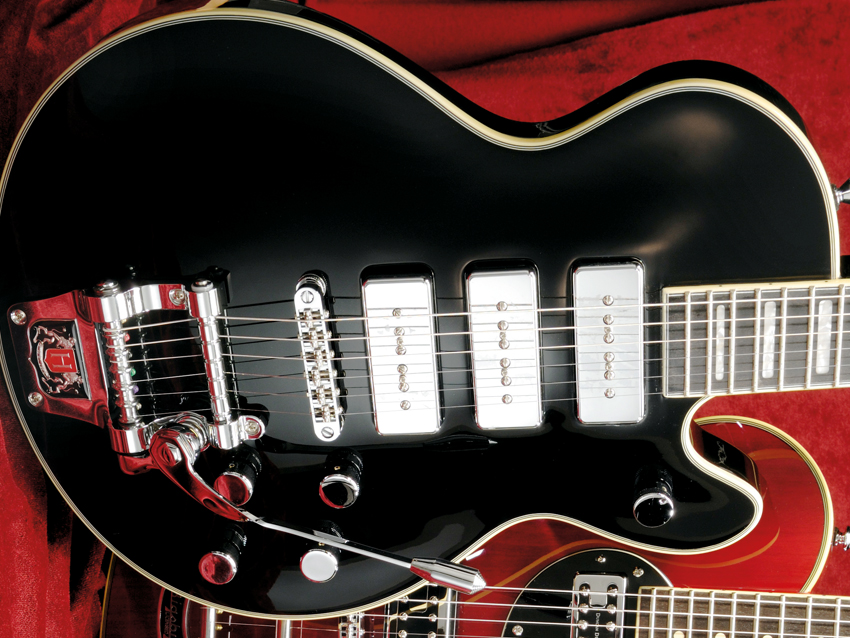
Hagstrom Super Swede Tremar P-90 £640
UPDATE: We've added two new vintage-vibe electrics - a Hagstrom Super Swede Tremar P-90 and a Schecter Solo 6 Vintage - both splicing old-school charm with a generous dollop of modern playability, build quality and an affordable price tag. See them both on the first two slides of this gallery or, if it's your first time here, keep on scrolling for a selection of guitars to suit every player’s taste - all under £1000…
Our list of the best electric guitars under £1000 represents some of the finest six-string instruments in the world today. From classic Strats to pointy Vs - every player and every style is catered for. But if you think that's an eclectic mix, feast your eyes on this lot…
Hand-picked from the pages of Total Guitar, here are 24 alternative models: why stop at a Strat when you could drive a Mustang? If you want a Tele, how about the 'pimped-out' J5 Signature? And why settle for an eye-watering Dean Razorback when you could cause some serious damage with a BC Rich Draco!?
We'll kick off with the Hagstrom Super Swede Tremar P-90...
Originally launched in Sweden in 1970, the Hagstrom Super Swede was a twin humbucker guitar inspired by the design of the Gibson Les Paul. 40 years on, the Super Swede is back (albeit now made in China like the entire Hagstrom range), and is now available with a trio of P90 singlecoil pickups and a vintage style vibrato aka Tremar.
The Super Swede features a six-position rotary pickup selector (bridge solo; bridge and neck; bridge and middle; middle solo; middle and neck; neck solo), a master volume and three tone controls. That’s one for each pickup!
We can’t claim the Swede’s unusual wiring suddenly makes perfect sense when you plug it in, but we’re pretty sure it won’t matter when you hear the quality of the pickups.
The high output (or ‘spiced’ in Hagstrom marketing speak) P90 singlecoils are the business. All three pickups have power and clarity in equal measure and they blow the competition away in this price range. The Swede’s tone is best described as fat.
Verdict
This guitar is a smorgasbord of tonal brilliance. That trio of pimped P90 pickups can produce anything from sweet jazz to snarling rock and punk tones. No mean feat. You may find the switching system initially confusing, but patience is rewarded with one of the greatest tonal palettes we’ve experienced. Hey, they don’t call it ‘super’ for nothing.
5 out of 5
Pros: Fantastic tones, build quality.
Cons: Controls can be confusing.
Next: Schecter Solo 6 Vintage
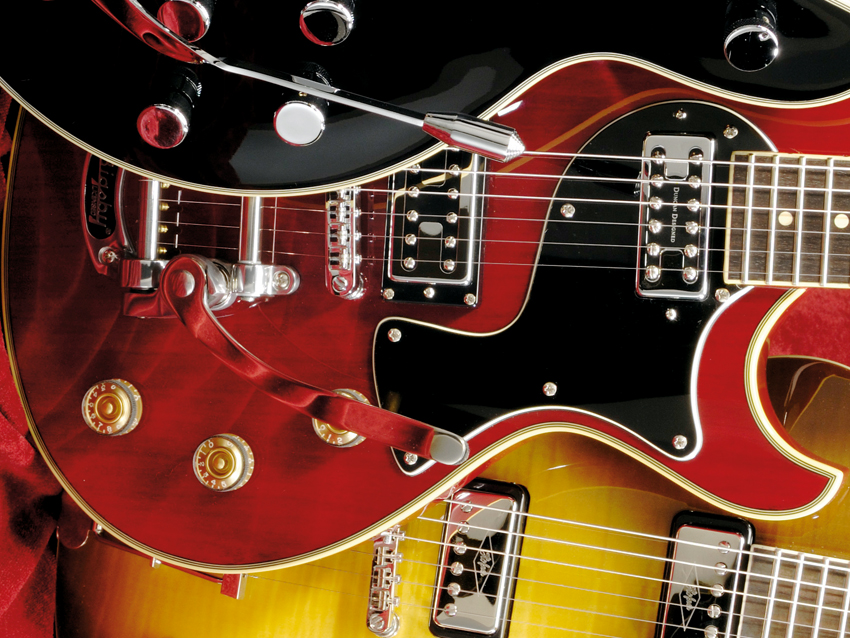
Schecter Solo 6 Vintage £599
Were a loved-up Gibson SG and an old Gretsch ever to get serious and take their relationship to the next level, the result would be a bouncing baby Schecter Solo 6 Vintage.
The SG would contribute the slab mahogany body, while the Gretsch would provide some rockabilly approved hardware that includes an obligatory Bigsby vibrato.
That desire to appeal to both rock and rockabilly players is reflected in the (Seymour) Duncan Designed humbuckers. The bridge position HB-102 humbucker is based on Seymour’s legendary JB model, while the FG-101 neck pickup is designed to pump out classic roots and rockabilly tones of the ‘50s.
The fact that Schecter has also fitted a coil-split makes the Solo 6 Vintage a versatile guitar that can run from blues, surf, country and rockabilly to rock and, yep, serious metal tones. All that aural gravy is backed up with excellent playability and upper fret access, and rock solid tuning stability despite that old-school vibrato unit.
Verdict
Bagging a Schecter Solo 6 Vintage allows you to give birth to tones as diverse as AC/ DC beef and Stray Cat twang at the flick of the pickup selector switch. This guitar is a true heavyweight both tonally and physically. That’s a fair old chunk of mahogany you’ll be hanging from a strap so make sure your spine can handle the weight. The only thing that isn’t heavy is the price tag. This baby is worth every penny, we reckon.
4 out of 5
Pros: Looks, tonal versatility.
Cons: Tis a weighty beast.
Next: G&L Tribute Rampage Jerry Cantrell Signature
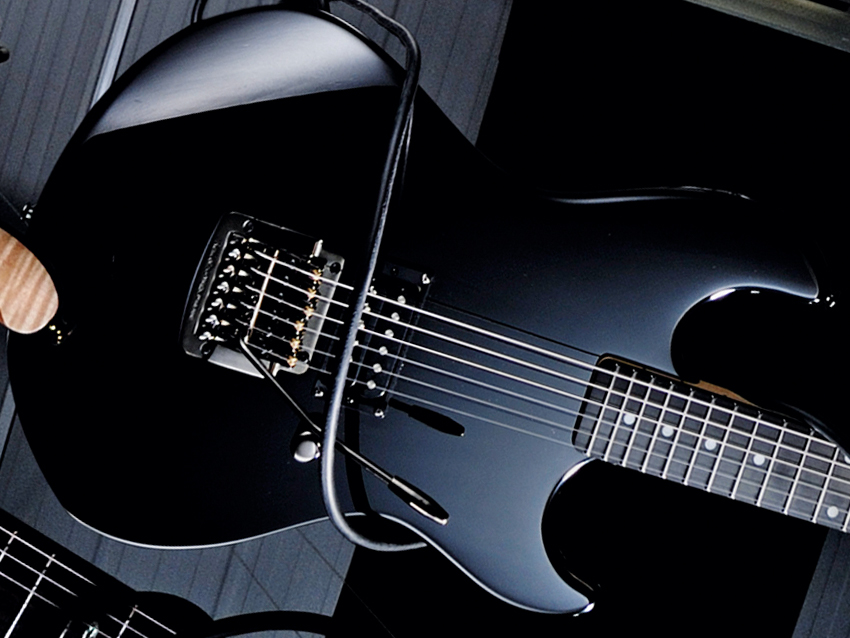
G&L Tribute Rampage Jerry Cantrell Signature £699
The G&L Rampage may have been consigned to the dusty racks of a hundred pawn shops if it hadn’t been for Jerry Cantrell of Alice In Chains.
He made his bones on an original ‘80s Rampage. This Tribute version is an affordable take on the man’s megabucks US signature Rampage, but don’t think that it’s just for Jerry fans. Thanks to its flat fingerboard profile, the G&L Tribute Rampage Jerry Cantrell Signature (try saying that with a gob full of Coco Pops) is a shredder’s delight.
In place of Jerry’s preferred Seymour Duncan JB humbucker a custom wound job keeps costs down while providing decent clean tones and enough power to satisfy anyone with a jones for the dirty stuff. The only sticking point on our guitar, literally, was the Kahler 4300 X-Trem vibrato which didn’t always return to pitch at first. Look out for that before you part with your lolly.
That aside, this Rampage is a killer ‘80s throwback with big price tag tone, sustain and playability.
Verdict
Getting hold of an original ‘80s Rampage at a reasonable price would be the Devil’s own task. That’s why this Tribute model has been causing such excitement among Cantrell fans and G&L aficionados. Aside from the fact that it’s not a particularly versatile guitar, we love its tone and playability. It’s also not a million miles away from the spec and build quality of Jerry’s US signature. Upgrade to a Seymour Duncan JB ’bucker and you’ll get even closer.
4 out of 5
Pros: Awesome shredder, bags of tone.
Cons: Lacks versatility.
Next: Sterling by Musicman JP50SBK
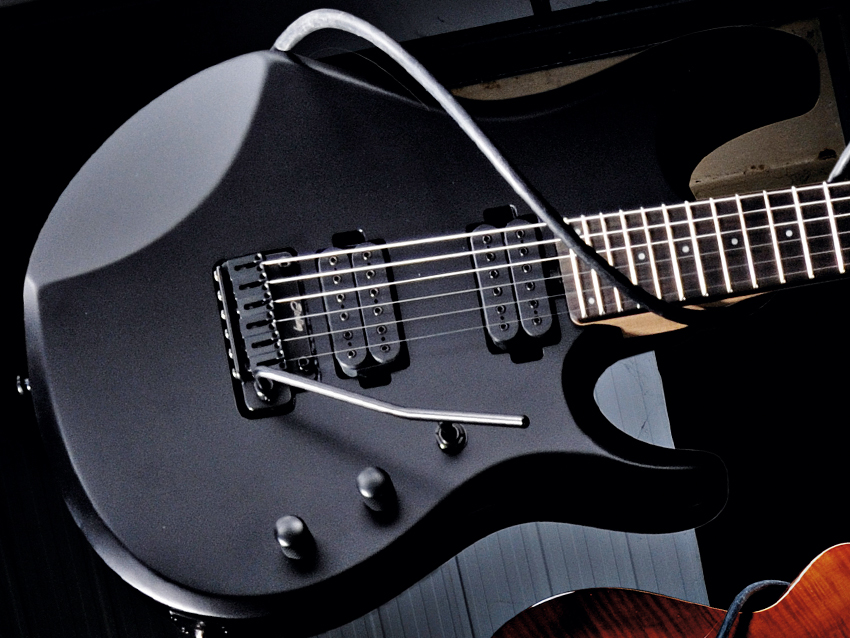
Sterling by Musicman JP50SBK £595
The Sterling by Musicman guitars and basses are the successors to the budget OLP (Officially Licensed Product) range of Musicman-a-likes launched a few years ago. Build quality and attention to detail have apparently been pimped in these new guitars. Oh, and the ‘JP’ in this model’s name stands for Dream Theater’s John Petrucci.
The JP50 is everything a great modern electric should be. Its lightweight basswood body is thoughtfully designed and features the comfort enhancing ‘forearm scoop’ from Petrucci’s US Musicman JP6 signature.
The slim maple neck is a revelation; we felt like we’d been playing it for years - pretty amazing for a mass-produced axe. The tuning stability also blew our socks off with those locking machineheads earning their keep big-time.
Tonally, the JP50 delivers everything you ask of it, from punk to blues to squealing pinched harmonics. If you play a bunch of different styles you’ll love this guitar’s versatile body mounted humbuckers.
Verdict
The JP50’s combo of first-class playability and versatile pickups wins it this test. Tuning stability is incredible and you don’t have to worship Mr Petrucci to look the part here. There is some wild talk that the Stealth Black JP50 is a limited-run guitar so you might need to get a wriggle on if you want that finish. See you in the queue.
5 out of 5
Pros: Versatile, tuning stability rules.
Cons: Move along please!
Next: PRS SE Mikael Åkerfeldt
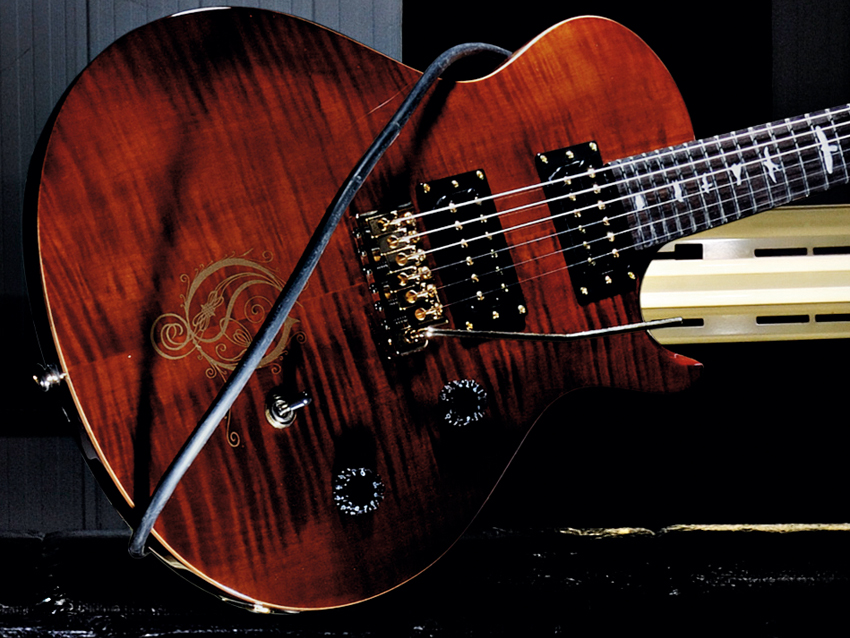
PRS SE Mikael kerfeldt £749
While both the Sterling JP50 and Ibanez EGEN8 (shown below) look like guitars that were designed from the ground up, the PRS SE Mikael Åkerfeldt is a variation on a familiar theme. The Opeth man’s guitar is basically a PRS SE Singlecut with a few custom touches that include a pretty Tortoise Shell finish, gold hardware and a flock of beautiful fingerboard inlays.
One of the greatest features of this SE model is the way that the glossy finish has been sanded flat from the neck heel to the top nut area. This is a brilliantly simple idea that prevents your hand from sticking to the neck when it gets a bit sweaty. From there, if you’ve ever played an SE model you’ll know what to expect.
This guitar will suit most players. The wide fat neck profile will work for jazzers, blues hounds and shredders alike, and the tuning stability means this guitar is unlikely to let you down at a gig or rehearsal. The only thing that might put people off is that gold ‘doodle’.
Verdict
It’s a shame that PRS and Mikael have limited this guitar’s appeal with that Opeth logo. As we said in our recent review of the PRS SE Nick Catanese, would it not make better sense to supply the logo as a sticker? Then it’s left up to you to decide whether you can live with the design or not. If you can live with it, though, you’re gonna get the classic PRS recipe of great tone and playability and, in this case, a silky smooth ‘wide fat’ neck to boot.
3 out of 5
Pros: Pickups, the sanded neck.
Cons: That bleedin’ logo!
Next: Ibanez Herman Li EGEN8
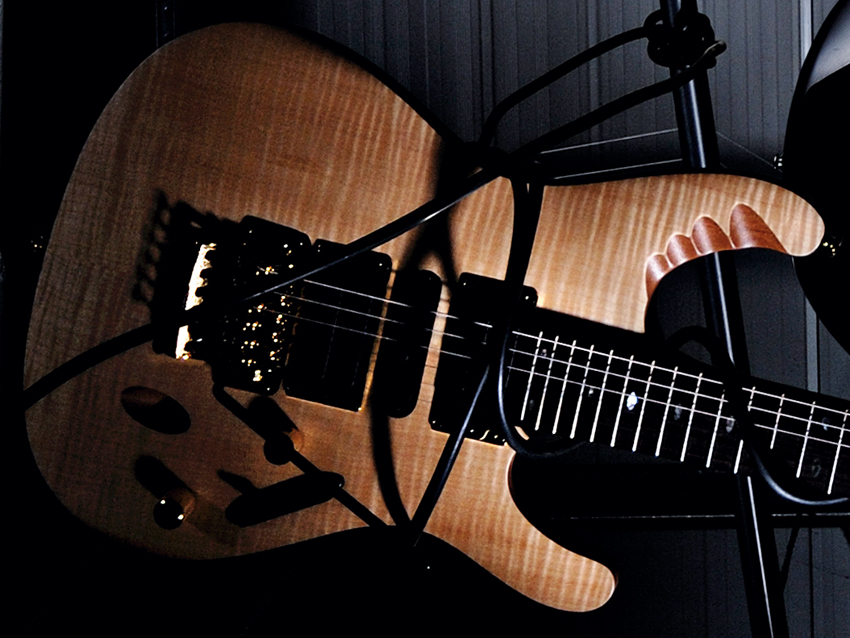
Ibanez Herman Li EGEN8 £649
While other guitars here come over like hot rods (a basic chassis with enough poke in the engine department to keep any player happy), the EGEN8 is more like a top-of-the-line Mercedes: it’s modern, sleek and loaded with all mod cons, including a shedload of pickup switching options.
Calling this guitar the budget version of DragonForce guitarist Herman’s two grand plus EGEN18 signature is a bit unfair. The slim-bodied EGEN8 is a proquality instrument in every way.
OK, you don’t get the DiMarzio pickups, partially scalloped fingerboard or top spec Edge- Zero vibrato from the more expensive version. What you do get is a cracking set of Ibanez pickups and the rock solid tuning of the Edge III locking vibrato.
Playability is everything you’d expect, and its range of tones is staggering. Thanks to the push/ pull volume control, the pickup selector’s five switching options have been expanded to 10.
Verdict
You could play Wonderwall on this guitar, but the EGEN8 will be most at home with dedicated shredders. It’s designed to provide serious playability and a huge range of tones - and does its job brilliantly. We also love quirky touches like the hand grip on the upper horn. It was only the potential wider appeal and killer neck of the JP50 that prevented the EGEN8 from winning.
4 out of 5
Pros: Beautifully made, range of tones.
Cons: For shredders only.
Next: Jackson RR24
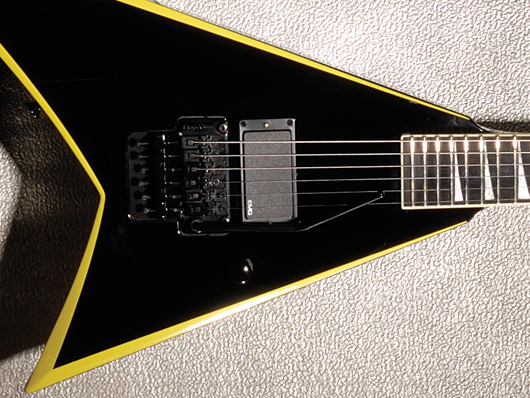
Jackson RR24 £899
One of the last things Randy Rhoads did before that tragic plane crash was collaborate with Grover Jackson on a radical new ‘V’. With eight variants now on Jackson’s books, we hope he’s getting the royalties up there.
While not strictly a V, the RR24 is arguably the most iconic metal axe ever. Spec’ed somewhere between the US and entry-level models, there’s plenty going on beneath the surface here; from the offset alder body and two-octave maple thru-neck, to the double-locking Floyd Rose vibrato and active EMG81 humbucker.
Don’t like the colour scheme? There’s a white version available too.
Jacksons are rightly revered for their speed, and the RR24 won’t do that reputation any harm thanks to a compound 14 to 16-inch radius board that flattens as you climb the frets. Physically, you’ll get far more out of the RR24 when you throw shred techniques at it; this baby excels at neo-classical, finger-twisting riffs and tapped solos.
Verdict
The RR24’s one pickup configuration and lack of tone control means it ain’t exactly adaptable. The EMG81 is a stellar pickup, but it doesn’t really do mellow. You’ll find yourself doodling with the amp dials if you want anything approaching warmth. But stop complaining, hit the gain and start soloing, and you’ll realise that you can’t beat the 81 for pin-sharp clarity under serious filth.
This is a shred guitar. Use it for shredding and you can’t go wrong.
4 out of 5
Pros: Iconic styling and seething tone.
Cons: Limited tweaking potential.
BUY: Jackson RR24 currently available from Andertons Music Co., Thomann and PMT Online
Next: Fender '65 Mustang
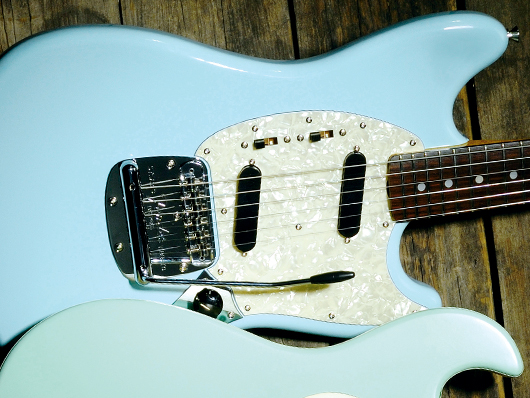
Fender '65 Mustang £699
The Fender Mustang was originally launched in August 1964, but its first full year of production was 1965 - hence the reissue’s name. The Mustang was an entry-level student guitar that went on to be popular with famous folk like Kurt Cobain, Blixa Bargeld of Nick Cave And The Bad Seeds, John Frusciante and Graham Coxon of Blur.
The Mustang here on test is part of Fender’s Classic Series. It features the poplar body of the original guitar as well as other period-correct details like the white-buttoned machineheads, ’65 headstock logo and floating Dynamic vibrato.
Look around and you’ll pick one up for £499.
If you’ve never played a Mustang, you’re in for a treat. The compact body and shorter scale neck make the guitar a dream to play. The strange-looking floating vibrato is very smooth and, as long as you’ve given your strings a good stretch, it won’t knock the guitar’s tuning out.
Verdict
Plugged in this guitar offers a range of bright tones selected via slider controls. If you’re expecting to emulate Kurt Cobain’s raucous tone you may be disappointed with the Mustang’s mild-mannered single-coils; Kurt preferred a humbucker in the bridge position. The Mustang is more ‘60s garage punk. Few axes combine vintage tone, stunning looks and easy playability as well as this.
4 out of 5
Pros: Beautiful looks, vintage tones.
Cons: A wee bit pricey.
BUY: Fender '65 Mustang currently available from Thomann and PMT Online
Next: ESP LTD EC-401FM
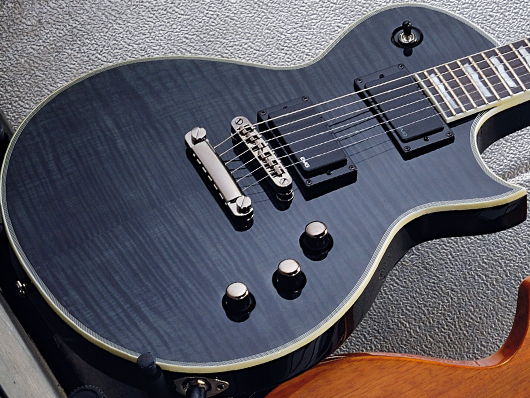
ESP LTD EC-401FM £849
The name might be as sexy as damp slippers, but the EC-401FM represents the lofty peak of the LTD range. If James Hetfield were reading this, he’d shout, "Hell, yeah!" and send his butler out for one immediately.
On paper, the only lame thing about the EC-401FM is that we’ve paid £849 and it still doesn’t say ‘ESP’ on the headstock (despite a spec that mirrors ESP’s Eclipse-II range.) The ‘FM’ stands for ‘flame maple’ (as in the cap that sits atop the mahogany body) but it could equally mean ‘For Metal’, with EMG 81 and 60 active humbuckers.
All evidence suggests LTD has this model down as a Les Paul-beater, perhaps for the player who fancies Zakk Wylde’s signature Gibson, but doesn’t own a goose that lays golden eggs.
It wouldn’t kill LTD to make its models look more original, but the EC-401FM stands out from other Les Paul wannabes with a significantly lighter mass and a dead-thin neck that gets your fingers firing. But its relatively slim dimensions won’t compromise your tone.
Verdict
Thick and buttery when clean, this guitar is dark, malevolent and dripping with sustain under distortion, with the neck ’bucker supplying a dense crunch and the razorblade sneer of the bridge meaning you won’t miss your precious PAFs for a second. Granted, this model doesn’t exactly break new ground, but it’s the perfect choice for bursting ears and cracking skulls.
4 out of 5
Pros: Savage EMG tone, easy to play.
Cons: Derivative looks and format.
BUY: ESP LTD EC-401FM currently available from Andertons Music Co., Thomann and PMT Online
Next: Parker P-44V
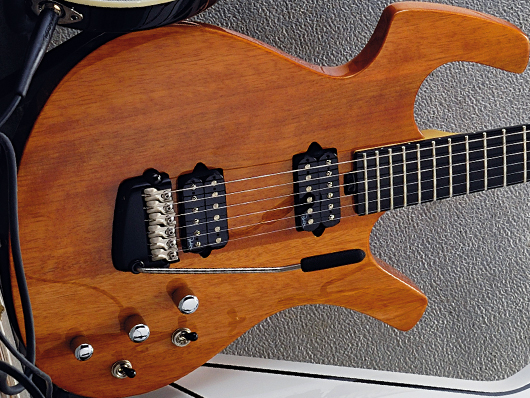
Parker P-44V £699
By 1997, some players thought that the electric guitar was at a dead end. Enter Ken Parker, a bushy-bearded maverick whose Fly model fused electric and acoustic in a package that looked like it had fallen off the Starship Enterprise. This is the cheap version.
The P-44V "has the signature capabilities of the high-end Fly in a beautiful solid mahogany body,” notes the Parker website, before playing the trump card: “The humbuckers deliver twang and shimmer… count on the piezos for a very realistic acoustic sound, then mix them with the magnetics for a hybrid that introduces a whole new dimension to music.”
Run your hands along the gorgeous neck and tickle a few licks from the humbuckers, and you’ll realise that this is a different class. By the time you’ve explored the mind-boggling versatility of that pickup configuration, you’ll be punching in your PIN.
Hit the bridge humbucker for ear-melting shred, try the coil splitter for snappy rock solos and select the piezo pickup for warm acoustic rhythm parts.
Verdict
The crazy mixture of mag’ and piezo can’t be described on paper. Critically, these disparate sounds are always underpinned by the P-44V’s unique flavour, meaning this axe actually has a really strong personality.
5 out of 5
Pros : Mind-blowing versatility, feel.
Cons: Zilch.
BUY: Parker P-44V currently available from PMT Online
Next: PRS SE Paul Allender
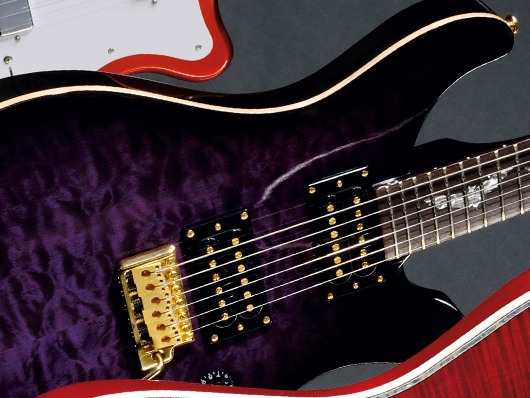
PRS SE Paul Allender £649
Come the day that he decides to give up dressing in scary makeup and calling Jesus a lady’s front bottom or something, Cradle of Filth’s Paul Allender could consider a career in guitar design. His SE model proves that a guitar can sound mean and still look pretty.
Paul had this to say about his SE signature model: “It sounds so aggressive and plays amazingly. I can’t believe it’s an SE. It’s so good that I’m going to play it onstage with Cradle of Filth.”
We’re with Paul on this one - this guitar is the balls! It’s light and well-balanced, plays beautifully (thanks to a slim neck), and looks the business. Allender has managed to breathe some fire into the well-worn PRS formula replacing the classic bird fingerboard inlays with awesome-looking bats.
We love that purple Allender Burst finish too.
Verdict
Plugged in, this guitar is versatile with enough tonal variation to handle any genre from country to rock, though most of these guitars will end up in the hands of metal players. SE Allender models are flying out of music shops like a bat out of hell, in part because of its street price of around £500. Just don’t expect these beauties to hang about.
4 out of 5
Pros: Stunning looks, playability.
Cons: You need to share Paul’s taste.
BUY: PRS SE Paul Allender currently available from Andertons Music Co., Thomann and PMT Online
Next: Dean SplitTail Floyd
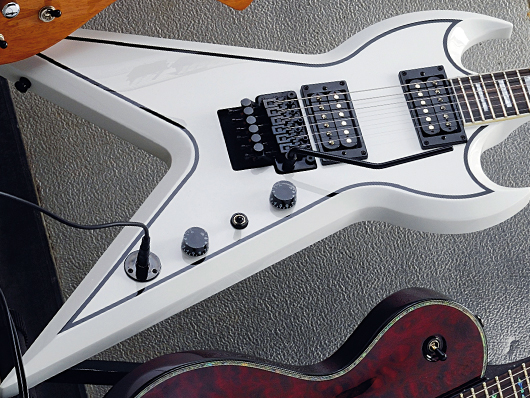
Dean SplitTail Floyd £949
Remember when scientists grafted a human ear onto a mouse’s back? Dean’s SplitTail is the same concept, mashing up a doublecut front end with a V-shaped tailpiece.
Dean reckons the SplitTail is unique, but we’re not sure, with Zakk Wylde’s Epiphone ZV looking like a brother-from-another-mother on the shelf. We wouldn’t say it to Zakk’s face, but the SplitTail Floyd spec is marginally tastier, with the all-mahogany body and set neck bolstered by Dean’s DMT USA Time Capsule humbuckers and an original Floyd Rose vibrato.
We love the SG. We love the Flying V. Bolt them together, though, and it feels like too many ideas stuck on one guitar. But don’t put your wallet away...
Verdict
While the SplitTail is divisive to look at, in terms of finger velocity, this is undoubtedly a slick performer, balancing better than you’d think and letting you burn across the neck and pull off every Floyd Rose party piece in the book.
The tone ain’t too shabby either. Voiced to recreate Dean’s legendary '70s models, those Time Capsule humbuckers drip with ragged character, boxing your ears with beefy lows and mids, and ensuring this guitar isn’t just a soulless widdlestick. Close your eyes and you’ll be smitten. Open them and this is guitar Marmite.
4 out of 5
Pros: Speedy feel, characterful tone.
Cons: Expensive, divisive looks.
Next: Schecter Hellraiser Solo-6
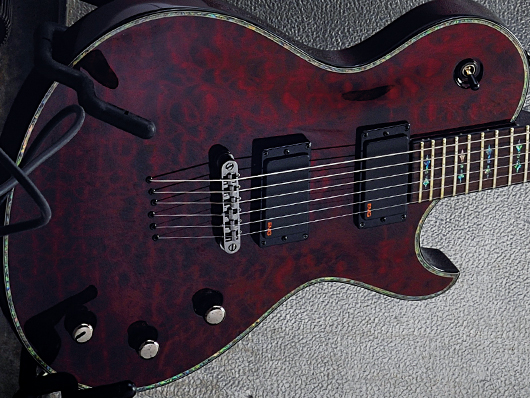
Schecter Hellraiser Solo-6 £749
From humble roots as a spare parts specialist in '70s California, Schecter has blossomed into one of the most credible names on the modern rock scene. Not since Pussy Galore has a name promised as much as the Hellraiser Solo-6.
The contours of that time-honoured mahogany body might scream, ‘Les Paul derivative!’, but there’s more to this model, with 24 XJ frets lined up on the ‘ultra-access’ mahogany set neck and a 25.5-inch scale that will be more familiar to Strat fans. And if you think you’ve got the number of those active EMGs, you might be surprised to find the volume pots break ’em into single-coils.
In the future, humanoids will look at the Hellraiser and wonder how anyone could play anything so cumbersome. More fool them. The girth of this singlecut is precisely what makes it so cool, with the neck swamping your palm compared to the LTD, the body hanging at your side like a barn door, and the resulting sustain ringing out for days.
Verdict
Sure, those EMGs mean your riffs drop like cluster bombs, but you’ll do far more than chug, with the generous neck access combining with the longer scale to get you climbing the fingerboard, bending notes and squeezing out idiosyncratic vibrato.
As long as you don’t split the mighty humbuckers into relatively wimpy single-coils - which is like putting a muzzle on a pet dinosaur - you’ll be in heaven. Or possibly hell.
4 out of 5
Pros: Beefy dimensions make it soar.
Cons: It’s a bit of a bloater.
BUY: Schecter Hellraiser Solo-6 currently available from Thomann
Next: Peavey PXD Tragic II
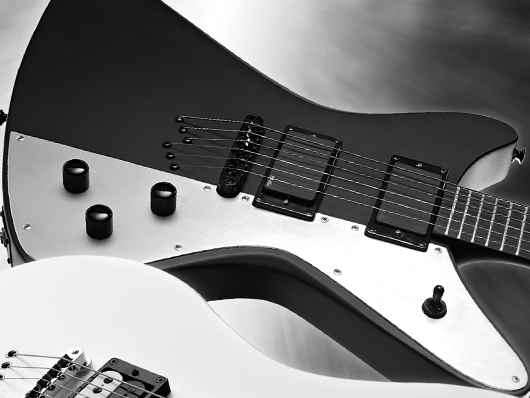
Peavey PXD Tragic II £590
When a guitar arrives in a coffin flight case, it’s always a good sign. When the Grim Reaper appears beside you in a puff of foul-smelling smoke and asks if he can “have a go”, it’s an even better one.
Peavey envisages the PXD Series as the “perfect complement” to its existing 6505 amps, as cranked by Trivium, Machine Head et al, and though we’re running it through a Marshall, we’re hoping the firm’s claims still ring true.
“With supercharged active pickups anchored to menacing slabs of tone-sustaining mahogany,” trumpets the Peavey marketing department, “PXD guitars are built for speed, slicing leads and razor-sharp riffs.” Of greatest interest to technophiles is the innovative EMG-AB Afterburner tone circuit, which claims to “boost input gain up to 20dB for the highest levels of saturation.”
Verdict
The Tragic is reasonably priced, well built, won’t tie you to metal and combines bullet-proof foundations with flashes of whimsy - the sensible choice. Visually, you’ll draw parallels with an Explorer, but there’s actually better access, a neck profile that gobbles up virtuosity and a matte finish that stops you sweating like a pig.
The Tragic’s clean voice isn’t as subtle as some, but you’ll forgive it when you make those EMGs angry and get a Hetfield crunch and brittle Hammett leads. The only letdown is the Afterburner, whose tone-shaping is hardly the stuff of revolution.
4 out of 5
Pros: Great value for a spec like this.
Cons: Clean voice, Afterburner.
Next: Ibanez Xiphos XPT700
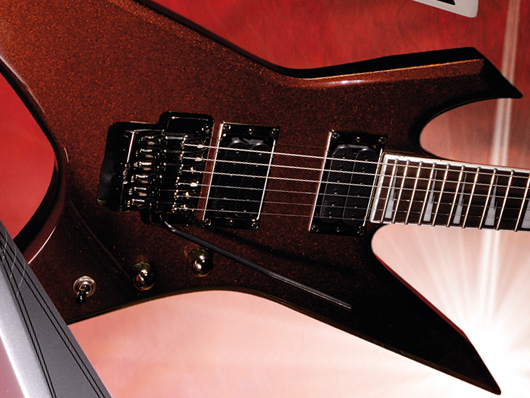
Ibanez Xiphos XPT700 £599
As all bearded historians know, the xiphos was a double-edged sword wielded in battle by the ancient Greeks. Fast forward to the present and it refers to a double-cutaway axe wielded at gigs by modern hair balls.
Ibanez reckons “the Xiphos is like something out of a sorcerer’s nightmare”. We don’t know about that, but it certainly resembles a metal head’s wet dreams, with the spangly ‘flip’ finish and savage styling evoking a sharpened dodgem.
Look closer and you’ll question the £599 price tag: we’ve got a mahogany body, five-piece Wizard II thru neck, DiMarzio D-Activator humbuckers, an Edge III vibrato and drool running down our chin.
The Xiphos’ angular body makes a hell of a visual statement. Strap on and it feels like a less clunky Explorer, and the deep cutaways offer unhindered access to the top frets to keep shredders happy. We’ve seen the Wizard II neck a few times and it’s fast as hell - the thru format is a bonus - while the Edge vibrato handled hard bends in both directions.
Verdict
Ibanez has played a blinder getting DiMarzio involved with this guitar, and the twin D-Activators ’buckers are the best feature here. These units aren’t just facilitators of moronic shred: the neck has body and soul when you play it clean, the bridge has a classy bite, and both respond to picking dynamics in a way that is rare at this price point.
Just a shame it doesn’t feature the coil-splitting feature of pricier Ibanez axes.
4 out of 5
Pros: Physical comfort, classy pickups.
Cons: No five-way pickup selector.
BUY: Ibanez Xiphos XPT700 currently available from Andertons Music Co. and Thomann
Next: Höfner Contemporary Series Club
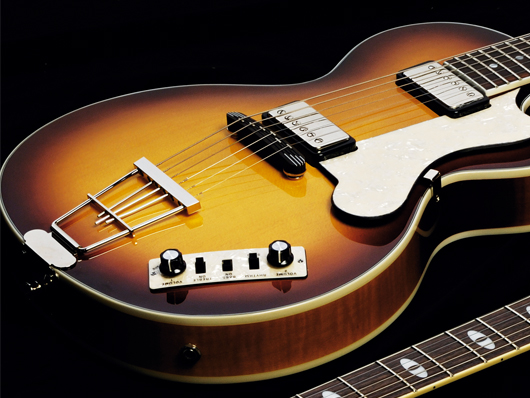
Höfner Contemporary Series Club £525
Don’t be alarmed if wet patches appear on your keyboard. It’s merely your father (who can remember Lennon and Harrison playing Höfner Clubs in the ‘60s) drooling over your shoulder…
The Höfner website gives few spec details on the Club but assures us that the ‘60s style guitar before us is no museum piece: “These models are designed for the tough live performance of today’s guitarist. The Club includes a sustain block for a more modern sound, and by virtue of its compact body dimensions it is less susceptible to feedback, even at high volume.”
The ‘60s vibe of the Höfner is spot-on, even if the slavish authenticity can sometimes be a headache (the control panel, for instance, is baffling and archaic). True to Höfner’s claims, the aesthetics conceal a bullet-proof modern gig weapon, with the bowl-back semi-acoustic body finished to perfection and the neck capable of more than jangled 7th chords.
Verdict
Be careful with the tone. The ‘rhythm’ setting can be soupy and the ‘lead’ a little shrill, but with patient twiddling of the control board and amp, you’ll unlock the holy grail - a fat-bottomed Merseybeat thump served up with plenty of shimmer, decent sustain and no shrieks of feedback.
Nostalgic for the golden age of rock ’n’ roll? Join the Club.
4 out of 5
Pros: Brilliant looks, feel, '60s tone.
Cons: Stupid controls, a tad shrill.
BUY: Höfner Contemporary Series Club currently available from Thomann and PMT Online
Next: Fender J5 Triple Tele
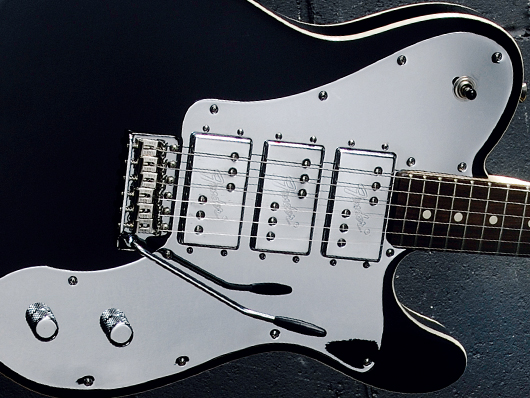
Fender J5 Triple Tele £699
The Telecaster is 60 years old. When you’re that age ‘the yoof’ will just think you’re an old fool while the Tele is still cutting it with the kids thanks to cutting-edge signature models from the likes of Jim Root of Slipknot and John 5. Speaking of which…
The J5 Triple Tele Deluxe is based on a ‘70s Telecaster Deluxe, a Tele/Strat hybrid that some cruel folk nicknamed the ‘Uglycaster’. But Johnny 5’s axe looks pretty tasty thanks to a load of pimped-out chrome and sexy black paint.
This guitar is almost brilliant. We love the comfortable ‘60s-style C-shape neck profile, the three powerful Enforcer humbuckers, the 22 fat frets and the rock-solid tuning stability provided by the locking machineheads. And a padded gigbag is included in the price.
All gravy but there are a couple of potential deal breakers. For a start, the J5 is a real heavyweight. Everyone in the office that picked the guitar up exclaimed, ‘Jeez, that’s bloody heavy!’ We wouldn’t fancy strapping this guitar on for a whole gig. We also kept whacking our pick off that middle humbucker, a common problem with triple ’bucker guitars. It’s not a serious downer, just annoying.
Verdict
If these niggles haven’t put you off the J5 Tele make sure you shop around: we’ve seen this guitar online for as little as £569. Great guitar but not quite a five out of five, er, Mr 5…
4 out of 5
Pros: Killer looks, superb neck.
Cons: Heavy! Obtrusive ’bucker.
BUY: Fender J5 Triple Tele currently available from Thomann and PMT Online
Next: BC Rich Draco
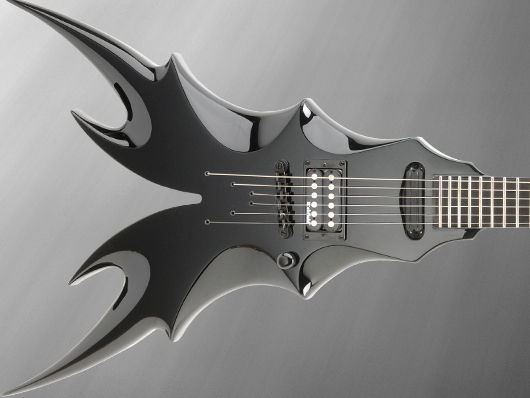
BC Rich Draco £715
There aren’t many axes that can make the Dean Razorback look like a butter knife, but BC Rich has done it with the new Draco. Test it? We’re scared to even touch it…
Winning features like the mahogany thru-neck, ebony fretboard and twin-rail neck pickup all support a considerable price tag, but it’s the Rockfield Fat Ass bridge ’bucker that offers most potential.
“The Rockfield was designed for players that have those crazy super-acrobatic styles that we all stare at in amazement,” notes the website. “The custom bobbins house larger polepieces that help transfer string vibration from pulls, bends and leads for less tonal drop-off and better articulation and note definition.”
Verdict
While it’s visually as divisive as Marmite and should probably offer a vibrato, the Draco balances better than you’d think and impresses with the bend-friendly fretboard and the endless sustain of the thru-neck. A combined volume/pickup selector gives the choice of neck or bridge - but not both - and the absence of a tone further squeezes options, but who needs tweakability when the default setting rocks this hard?
The rail is thick and thumping, but it’s the Fat Ass that hits hardest, matching the claims of pin-sharp clarity and lending unique sneer to solos. We like.
4 out of 5
Pros: Eye-popping visuals, bridge tone.
Cons: You risk looking ridiculous.
BUY: BC Rich Draco currently available from Thomann
Next: ESP LTD MH-401QM

ESP LTD MH-401QM £829
Along with leather trousers from Prada and a nose ring from Tiffany, the luxurious LTD MH-401QM is the automatic choice of the executive metaller. If this guitar were any more expensive, it’d be an ESP.
LTD doesn’t mess about by pretending that all axes are created equal. Take a squizz at the website and you’ll find the MH-401QM at the head of the MH family, confirming its flagship status with a spec whose highlights include a set-thru maple neck, svelte mahogany body topped with quilted maple, active EMG 81/85 humbuckers (powered by a nine-volt battery for monster output) and a Floyd Rose Special bridge.
And the second indication of how seriously LTD takes this model? The hefty £829 asking price - a prohibitive figure confirming the great unwashed need not apply.
We’ve tried several MH models, but this is a different class. It doesn’t look overtly metal, but plays a blinder, with the ergonomic doublecut giving total freedom and the Floyd and speedy U-profile neck suggesting that if you can’t sound good on this guitar, give up.
Verdict
We all know about the malevolent grind of EMG’s 81 and 85, and here they sound even more dangerous, flavoured by the mahogany and the sustain of the neck format. What surprises is the edgy shimmer of the clean voice… like an iron fist in a velvet glove. Technically, it’s a great guitar. But at £829, it damn well should be.
4 out of 5
Pros: Luxurious feel, glorious tone.
Cons: Too expensive for many.
BUY: ESP LTD MH-401QM currently available from Andertons Music Co. and PMT Online
Next: Gibson V-Factor X
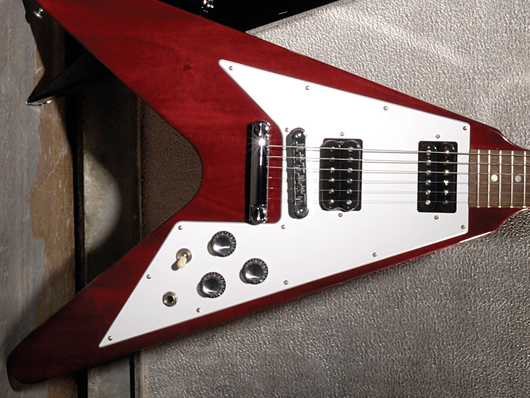
Gibson V-Factor X £850
Back in 1957, Leo Fender started telling anyone who’d listen that Gibson was stodgy and never had any new ideas. Gibson boss Ted McCarty took that as fighting talk, and promptly built the Flying V.
Don’t be fooled by the suncream-sounding name. The V-Factor X is essentially a 1967 Flying V, with some of that model’s more antiquated features ironed out for the new millennium. Critically, the iconic mahogany body and arrow headstock of yore remain, while the replacing of the original PAFs with 496R (neck) and 500T (bridge) humbuckers suggests that this old log has learned some new tricks.
50 years on, the Flying V has lost none of its power to divide. We’re firmly in the ‘classic’ camp: we love the gonzoid looks, the no-nonsense hardware and the ‘50s/’60s hybrid neck profile. At the same time, it’s quite heavy and very cumbersome, isn’t easy to play sitting down, and it doesn’t fit in some guitar stands.
Verdict
Luckily, plugging the V-Factor X into a Marshall is enough to make such quibbles evaporate. Under moderate distortion, the neck pickup has monster depth but retains sufficient bite for your blues solos to slice through the mix.
Over at the bridge, you’ve got a powerhouse sneer that sustains for ages and gobbles up lead work. There’s mahogany warmth across the spectrum, perfect weight distribution, and it makes you approximately 54 percent more attractive to the opposite sex. It’s still the daddy.
5 out of 5
Pros: It’s a bona fide legend.
Cons: It’s kinda impractical.
Next: Dean Vendetta 4.0
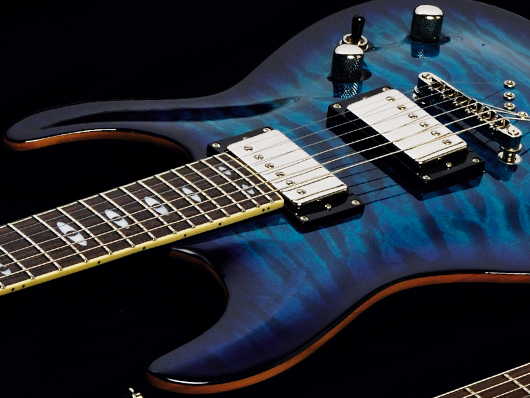
Dean Vendetta 4.0 £599
Even the most die-hard metal fan enjoys a break from the confines of a black paint job, so we selected Dean’s Vendetta 4.0 in a cool looking Trans Blue finish…
This Vendetta’s not your usual pick of metal lords Dean’s crop; it fits in a stand for a start. But while the body takes a more standard form, it’s dressed in a striking quilted maple top and back with cool ‘Evil Eye’ inlays glaring back at you from the fingerboard.
Still, it’s not just a pretty face - Dean axes are as big on tone as they are on aesthetics, after all - so you get a solid mahogany body, thru-body neck and stringing, a fixed bridge and a brace of Dean humbuckers that leave you in no doubt that the Vendetta 4.0 is cut from a cloth that’s well and truly ready to rock.
When you strap on this Dean its thin body fits you snugly - it’s comfortable for seated practice as well, unlike some of its spikier brothers. Its neck scores on comfort factor too, as we easily clamp barre chords on the accommodating ’board.
Verdict
Tone wise, the clean sound is sweet enough, with the thru-neck certainly adding some weight to the sound. But it’s when you crank the gain that the metal heritage on which the Vendetta is built comes growling to the fore. The dual humbuckers are a key element to the Vendetta’s tone, but this also make this guitar a shredder, and not particularly rounded.
4 out of 5
Pros: Very playable, sexy looks.
Cons: A bit one dimensional.
BUY: Dean Vendetta 4.0 currently available from PMT Online
Next: Washburn WV40 PROE Vindicator

Washburn WV40 PROE Vindicator £679
We had to look up ‘vindication’ in the office dictionary; it means justification. Let’s hope that Washburn can justify the £679 outlay that stands between you and this box-fresh silver bullet.
Rather than pretend the Vindicator is an option for jazzmen, Washburn admits this is "specifically aimed at the shredder" and has armed it with the hardware to survive in the metal bear pit. It’s mahogany all the way for the curvaceous ‘V’ body and two-octave set neck, while the combo of an official Floyd Rose and active EMG humbuckers puts it at a tangible advantage.
The Vindicator’s curved bout looks unorthodox, but it has negligible impact on the performance, with the WV40 offering the kind of access and roaring speed that everyone hopes for when they pick up a V.
It’s all about the gymnastics. Active humbuckers’ tendency to distort means they aren’t perfect for every scenario, but as we’ve established, the Vindicator is a shred tool and for that application you’ll find nothing better.
Verdict
At the neck, there’s a depth and muscle that makes the competition (even the DiMarzio-loaded models) sound thin, while the bridge sizzles when you tear through an alternate-picked solo. We’d take one of the others to a photoshoot, but tone is where it’s at, and there’s no arguing with the Vindicator on that score.
5 out of 5
Pros: Plays fast, sounds enormous.
Cons: Expensive, looks.
Next: Dean ML Exotic Spalt
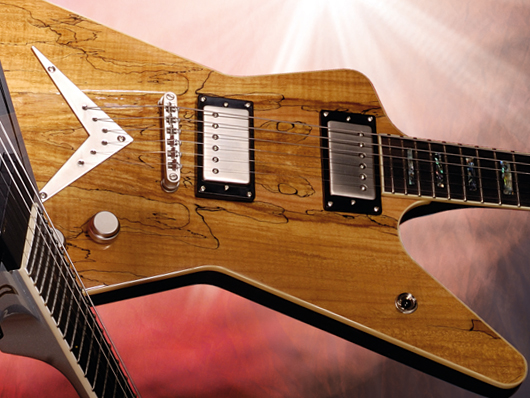
Dean ML Exotic Spalt £549
The ML ain’t exactly new - this is the model that gave a young Dimebag the horn as he flipped through the Dean catalogue in the ‘70s. But you’ve never seen one quite like this before.
Depending on how much you read into it, the exotic spalted maple top is either a sexy cosmetic trimming or a bid to reposition this model in the market.
“The thing about the ML,” notes UK distributor Bill Lewington, “is that it tends to get perceived as a metal guitar. So I think Dean is looking to aim at a different market - people who like exotic woods and want something more classic.”
Like Zakk Wylde in a double-breasted suit, it’s surreal to see this metal icon sporting a sophisticated spalted maple top and that brushed nickel hardware, and surprising how well it works.
Verdict
If metallers are unsettled by the face-lift, they’ll be coaxed back by the feel. For kinetic reasons, the ML is the ultimate shape for shredding, and here it’s consolidated by a quicksilver profile.
‘Own-brand’ pickups tend to be a snooze, but Dean has always been the exception and the ML scores again with its twin humbuckers. Crank the gain and an old-school roar hits you between the ears as the spalted maple and mahogany combine into a Molotov cocktail. If you’re growing up, but not growing old, this could be your dream ticket.
4 out of 5
Pros: Classic vibe, stunning spalt top.
Cons: Slightly primitive.
BUY: Dean ML Exotic Spalt currently available from PMT Online
Next: Dean Dave Mustaine VMNT1
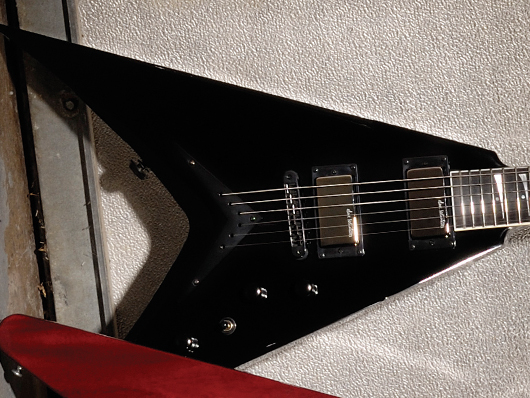
Dean Dave Mustaine VMNT1 £799
Dave Mustaine reckons his Vehement series “could be played by someone who doesn’t like Megadeth.” Don’t expect to see James Hetfield in the queue…
At £799, the VMNT1 is less ridiculous than the £3439 US model but more aspirational than the £269 entry-level axe. The spec is meaty, with lashings of mahogany embellished with twin active LiveWire humbuckers.
We question whether the VMNT1 is a wild departure from existing V electrics, with the only visual whimsy coming via the cool notches on the mahogany body. It’s hard to stay mad at this guitar for long though.
Featuring the slim neck profile specified by Mustaine himself, this model copes equally well with both sides of the Megadeth man’s style, supporting you when you thrash out complex rhythm parts and putting a rocket under your fingers when you solo.
Verdict
The physical performance is reason enough to take the VMNT1 off the shelf, but it’s the raw power of those active humbuckers that will have you reaching for your wallet. These bad boys crank out some of the darkest and dirtiest sounds we’ve heard in ages, with the neck turning in a menacing grind that demands powerchords and the bridge coming on like a banshee gargling nails.
4 out of 5
Pros: Humbucker tone, adaptability.
Cons: Design a bit conservative?
BUY: Dean Dave Mustaine VMNT1 currently available from Thomann and PMT Online
Liked this? Now read: The best electric guitars under £1000
Connect with MusicRadar: via Twitter, Facebook and YouTube
Connect with Total Guitar: via Twitter and Facebook
Get MusicRadar straight to your inbox: Sign up for the free weekly newsletter

Total Guitar is Europe's best-selling guitar magazine.
Every month we feature interviews with the biggest names and hottest new acts in guitar land, plus Guest Lessons from the stars.
Finally, our Rocked & Rated section is the place to go for reviews, round-ups and help setting up your guitars and gear.
Subscribe: http://bit.ly/totalguitar
“I wanted to design a pedal range that’ll last 10, 20, 30, 40 years... It could be something you could bequeath to those you love”: Exquisite stompboxes, built to last a lifetime, meet Red Witch’s Apothecary Series
“Gloriously adorned with a gold edge burst finish over a gold paisley and sparkle top”: Gretsch unveils the Paisley Penguin – a rare bird that growls – and the Honey Dipper Special, a resonator for all your roots rock manoeuvres
“I wanted to design a pedal range that’ll last 10, 20, 30, 40 years... It could be something you could bequeath to those you love”: Exquisite stompboxes, built to last a lifetime, meet Red Witch’s Apothecary Series
“Gloriously adorned with a gold edge burst finish over a gold paisley and sparkle top”: Gretsch unveils the Paisley Penguin – a rare bird that growls – and the Honey Dipper Special, a resonator for all your roots rock manoeuvres









